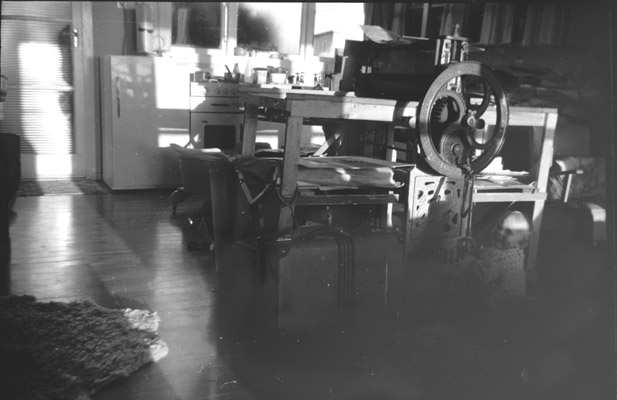 John Foster
John Foster
Printmaking
Woodcut or linocut

John carving a woodcut plate
The plate is a piece of hardboard or lino the size of the desired print. Pieces of the surface are carved away for the areas of the print that are desired to be white. Ink is rolled over the now embossed surface, the plate laid face down on the paper, and pressure applied with a printing press or other means.
A reducing masterplate means a single hardboard plate is hand carved for each edition. One colour at a time is printed over the whole edition of prints. More material is carved off the plate after each colour, and the next colour printed.
Most of John’s woodcuts use between four and ten colours.
Lithograph
A textured (grained) aluminium plate is drawn on with a waxy substance like crayon. It is then wet, and the ink is rolled on. The ink sticks to the dry image, but not to the wet grained plate. It is then printed in a similar way to a woodcut.
Lithographs often have the appearance of being hand drawn.
During the construction of the Shearing mural 1972-73 John began using aluminium masterplates for lithography. The method of regraining plates after an edition allowed the reuse of the masterplate for a different image. One plate could be recycled 200 times before it was too thin to reuse. This was further developed during Beckoning Land to allow for the alteration of the image during the printmaking process.

Adding different colours with successive printings
Etching
A metal plate is spread with wax. A drawing is cut into the wax, and the plate is soaked in acid so the exposed lines are eaten into the plate. The wax is then melted off. Ink sinks into the lines on the plate, and the print is taken with wet paper and high pressure. Etchings often have an appearance of being embossed.
Aquatinting is the etching of large areas rather than individual lines. Intaglio, drypoint, and engraving describe different ways of cutting the lines into a metal plate.
John developed the technique of masking out areas of the plate, then applying aquatint as a spray was used to create subtle mist and cloud effects while painting Overworld Journey.

John's first printing press